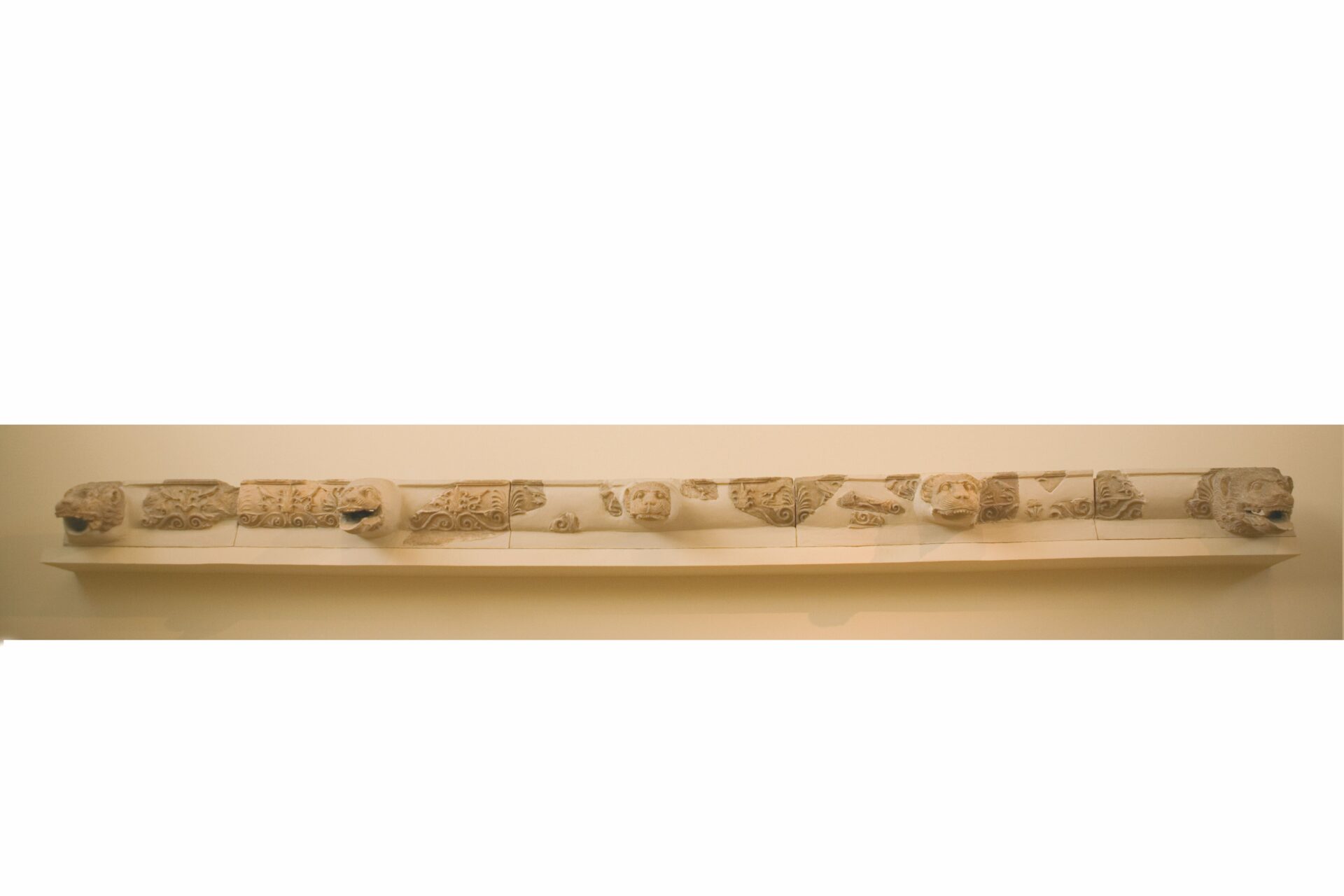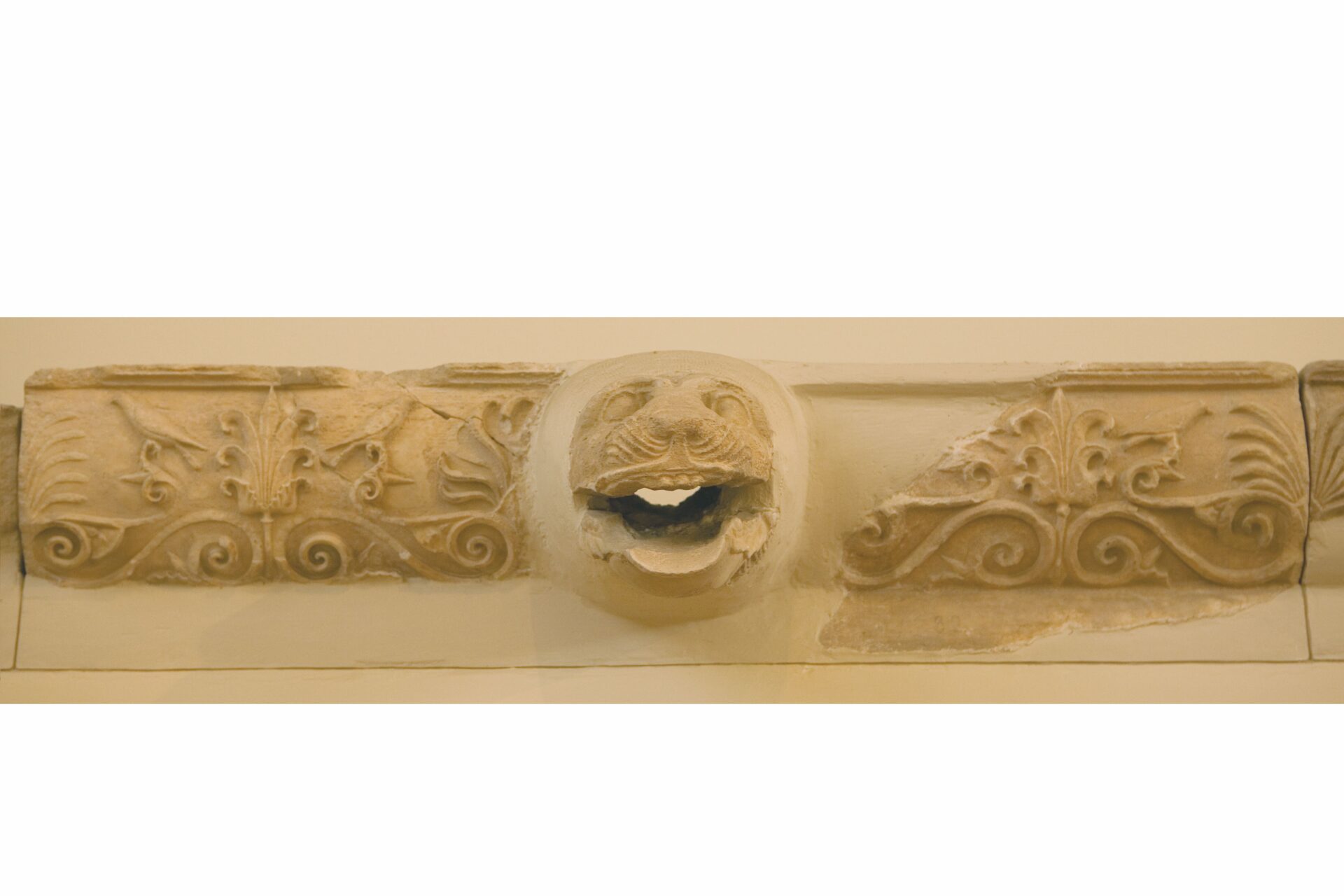Exhibit of the month
A cuckoo bird for goddess Hera
The sima of Heraion of Argos
Hellenic National Archaeological Museum
Sculpture Collection, inv.nrs 1579-1583, 3973-3975, 3979A, 4400-4404
Provenance: Argos
Dimensions: Height: 30,5 cm to 36 cm.
Date: 420-410 B.C.
Exhibition gallery: Room 17
Heraion of Argos is built on a low hill between Argos and Mycenae. The peripteral (with a peristyle) Doric temple of 420–410 B.C. was built by the Argive architect Eupolemos replacing an Archaic predecessor of the 7th century B.C. Today the foundation of the temple is preserved, along with parts of the entablature and the sculptural decoration. From the entablature of the Argive Heraion, many fragments of the marble sima (gutter) were found, which collected the rainwater from the rooftop. Several of them are housed in the Hellenic National Archaeological Museum.
The outer face of the sima is a fascia surmounted by an ovolo (convex moulding) decorated with a painted meander pattern in white and blue colour. The ovolo bears elaborate low-relief decoration. The decoration consists of alternating palmettes and lotus blossoms linked by spiraling tendrils. Interspersed with the palmettes and lotus blossoms are small birds perched on acanthus buds that emerge from the tendrils. The ground of the ovolo of the sima was blue, the tendrils and other floral elements carved in relief on the ovolo were probably left white for contrast with the dark ground. The lotus palmette motif is interrupted at regular intervals by lion-head waterspouts, flanked by half-flame palmettes, a lotus blossom and a half palmette at the joint. The roof was ornamented with naturalistically rendered floral acroteria, probably acanthus calyx surmounted by a pair of S-shaped stalks rising to a large split palmette for the central ones.
The floral decoration with palmettes raising from acanthus tendrils, alternating with lotus blossoms, is common in architecture and sculpture, either as a continuous frieze or as crowning element of pediments and funerary stelae and monuments. Rosaces, bell-shaped flowers (campanula), lotus buds and blossoms or lilies alternating with palmettes are depicted on the elaborate crown of the public funerary monument erected in honour of the deceased, who fell in the battles of Corinth and Koroneia. The artists in their efforts to enliven the geometric/linear motifs in art (architecture, sculpture, bronzeworking, vase painting) are inspired by nature. Although the palmette does not correspond to a particular plant, acanthus plant is native to Greece since antiquity. Large, lobed or toothed leaves are borne on the stem. The flowers emerge from the calyx, formed by the upper branch of leaves. The flowers are borne on an erect spike emerging from the leaf rosette). The natural vegetation with leaves emerging from spiraling tendrils, the diversity of the shapes and the colours of the blossoms contribute to the enlivening of the architectural decoration. Beyond the decorative purpose, the plants with their medical, fragrant and cosmetic qualities were sources of relaxation, pleasure, purification and healing of people in antiquity.
The monotonous floral decoration in the sima of Heraion is enlivened by the depiction of the small birds identified as cuckoos. The birds allude to the cuckoo that played a role in the story of the courtship of Hera by Zeus who changed into the bird. Cuckoo was also represented on the scepter held in the hand of the gold and ivory seated statue of Hera within the temple, created by the sculptor Polykleitos[1], according to Pausanias[2]. The distinctive call of cuckoos to attract a mate, is considered as a signal of the coming of spring.
Τhe depiction of the small birds on the sima of Heraion transforms the typical floral decoration with the multifaceted symbolism to an imagery of thenatural environment.
[1] The great master or a later namesake?
[2] Pausanias II:17.4.
Dr. Kalliope Bairami
Bibliography
For the sima and the acroteria of Heraion
Pfaff, Christopher A., The Argive Heraion, 1. The architecture of the classical temple of Hera, Princeton, New Jersey: American School of Classical Studies at Athens, 2003, 121-143, 185-189, 256-303.
Γ. Μοστράτος, Οι αετωματικές συνθέσεις των Πελοποννησιακών ναών του 4ου αι. π.Χ., Διδ. Διατριβή ΕΚΠΑ 2013, 17, 85-88.
For the development of the vegetal decoration in ancient Greek art
Έ. Βλαχογιάννη, Βοιωτικές ανθεμωτές επιτύμβιες στήλες, Διδ. Διατριβή ΕΚΠΑ 2003, 39-69.
Dictionnaire des antiquités grecques et romaines d’après les textes et les monuments. Ouvrage rédigé par une société d’écrivains spéciaux, d’archéologues et de professeurs sous la direction de Ch. Daremberg et Edm. Saglio, Paris 1877–1917, λ. Acanthus, 12-14 (Ε. Guillaume).
Ν. Καλτσάς, Πήλινες διακοσμημένες κεραμώσεις από τη Μακεδονία, Αθήνα 1988, 68ff.
Ι.Ε. Πετρόχειλος, Ανθεμωτές επιτύμβιες στήλες με λουτροφόρους, Αρχαιολογική Εφημερίς 142, 2003, 99-114.
For cuckoo and the depiction of birds on architectural sculpture
G. Wissowa, Paulys Real Encyclopaedie der Classischen Altertumwissenschaft τ. 21, 1921, st. 2099-2103, λ. Kuckuck [Gossen-Steier]
Έρση Richards-Μαντζουλίνου, Η φυτική διακόσμηση των κλασικών χρόνων, ΑΑΑ 14, 1981, 208-229.
Ι.Θ. Κακριδής (επιμ.), Ελληνική Μυθολογία, Οι θεοί, Αθήνα 1986, 90-94.
Η. Μοebius, Attische Architekturstudien, Mitteilungen des Deutschen Archäologischen Instituts, Athenische Abteilung 52 (1927), 162-196.
J. Pollard, Birds in Greek life and myths, London 1977, 176-177.
For the use of plants in antiquity
Αγγ. Λιβέρη, Η χρήση των αρωματικών φυτών και βοτάνων για την παρασκευή αρωμάτων και καλλυντικών στην ελληνική αρχαιότητα, στο Φαρμακευτικά και αρωματικά φυτά, Ζ’ Τριήμερο Εργασίας, Κύπρος, Παραλίμνι, 21-25 Μαρτίου 1997, 56-82.



